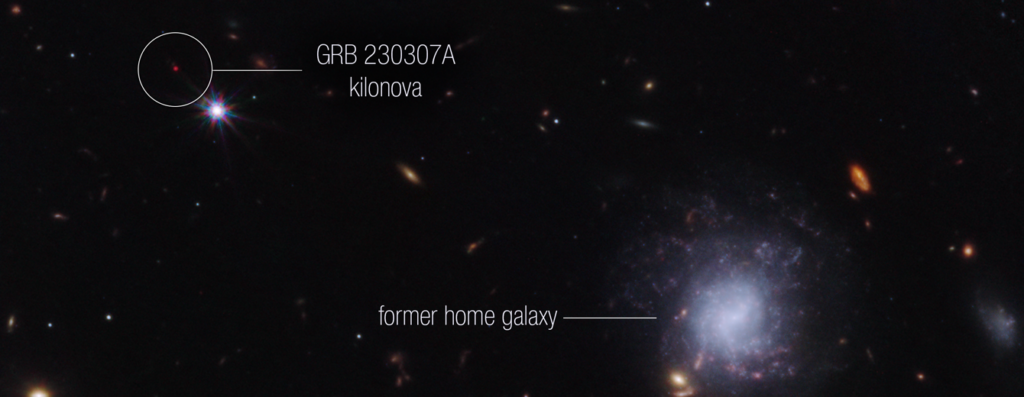
A collision of two stars in space is not something astronomers are used to seeing, even with powerful space telescopes trained on galaxies beyond our own.
But with the help of these massive eyes on the universe, including the James Webb Space Telescope, scientists recently got to see what such a space explosion – a kilonova – looks like, and what it leaves behind.
Michael Fausnaugh, an assistant professor of physics and astronomy at Texas Tech University,was part of the team that discovered what happens when two stars collide. He joined the Standard to share his insights. Listen to the interview above or read the transcript below.
This transcript has been edited lightly for clarity:
Texas Standard: “Two stars collide”: It almost sounds like like a tabloid magazine cover, but we’re talking about the celestial bodies here, folks. How often do they collide in the first place, or do you have an answer to that?
Michael Fausnaugh: Sure. The rates are hard to figure out. We see these things called gamma ray bursts about once a day. So, you know, they happen frequently in the universe. The thing that was exciting about the one we found is that it’s exceptionally bright. That has something to do with how close it is to Earth. And you have to get lucky. And this is something like once in 10 years or maybe even once 20 or 30 years.
Wow. Well, tell us about this kilonova. How did scientists come to find out about it in the first place? You keeping an eye on it?
NASA’s got a fleet of space telescopes that are monitoring the sky at all times, and we keep a close eye on the alert streams coming down from those things. So this particular event was found by the Fermi Space Telescope. And astronomers knew right away that it was super bright. This is the second brightest one that’s ever been detected in about 50 years of camera astronomy.
So what was your role in this, professor?
So I work with a different space telescope. This is TESS, the Transiting Exoplanet Survey Satellite. TESS was designed to find exoplanets, but the science I work on is all the other things you can do with TESS. We actually have a really unique observing mode, which lets us do different science, and we kind of have a comparative advantage compared to other telescopes.
» GET MORE NEWS FROM AROUND THE STATE: Sign up for Texas Standard’s weekly newsletters
And so you use that observing mode to spot what actually happened as a result of this explosion?
Yeah, that’s exactly right. So we knew immediately that this special gamma ray burst, that super bright, landed in the test field. So we got ready. I think the alert came out on a Tuesday, and we got the data down on Friday and spent all weekend poring over it and doing the analysis.
And it was a really spectacular light curve: We saw this super bright flash followed by a little bump and wiggle, which we call the afterglow. And it’s an observation you can only make with something like TESS, which does this kind of continuous monitoring strategy.
Tell us what’s so important about this event, and maybe for laypersons, what would you say scientists like yourself have learned from it?
I think there’s two main angles. One is these neutron star collisions: These produce the heaviest elements in the universe, stuff like gold and platinum. In this case, we discovered tellurium [synthesized in nature]. And so looking at events like this, you get a handle on where these heavy elements are synthesized.
The other aspect is that after they collided, they formed a black hole. And looking at all the physics at the very earliest time, both from Fermi and from TESS, we can get some handle on the black hole formation physics.
» MORE: Have scientists found the first dark stars?
Tell us more about TESS. How did it come into play here? Is it because it was able to see something other researchers couldn’t?
Yeah, exactly. So usually when something like this happens, you know, Fermi hits the trigger, and it sends out an alert and everybody goes and points their telescopes to look. But TESS, it does this observing strategy which is just staring at a big chunk of sky.
And we saw that event had landed in the TESS field, which meant that we had data before anyone else did, even before the trigger happened, so we could see if there was anything going on before or at the same time as Fermi. And that’s the key thing that TESS brings … we got the observation right at the moment that the stars collided and exploded.
What’s your theory or hypothesis on the formation of tellurium, the synthesiszation as you described it?
Yeah, it’s a process called the R process. These neutron stars are really dense and rich in neutrons, and when you collide them together, you get super high density. And the combination of all these neutrons together in a high-density environment, it lets you synthesize heavy elements beyond iron – so, like I said, gold, platinum.
In this case we measured tellurium. But there’s a whole host of, I forget how many, 10 or 20 or 30 elements that are very massive up on the periodic table.
How would you describe the practical implications of this, or are there practical implications?
Well, in some sense we’re studying fundamental physics, you know, looking at how black holes work, how strong gravity works, the neutron stars and their status is, again, fundamental physics. But, you know, all of the gold and many of the precious metals that we find on Earth very likely originated in neutron stars like them.
